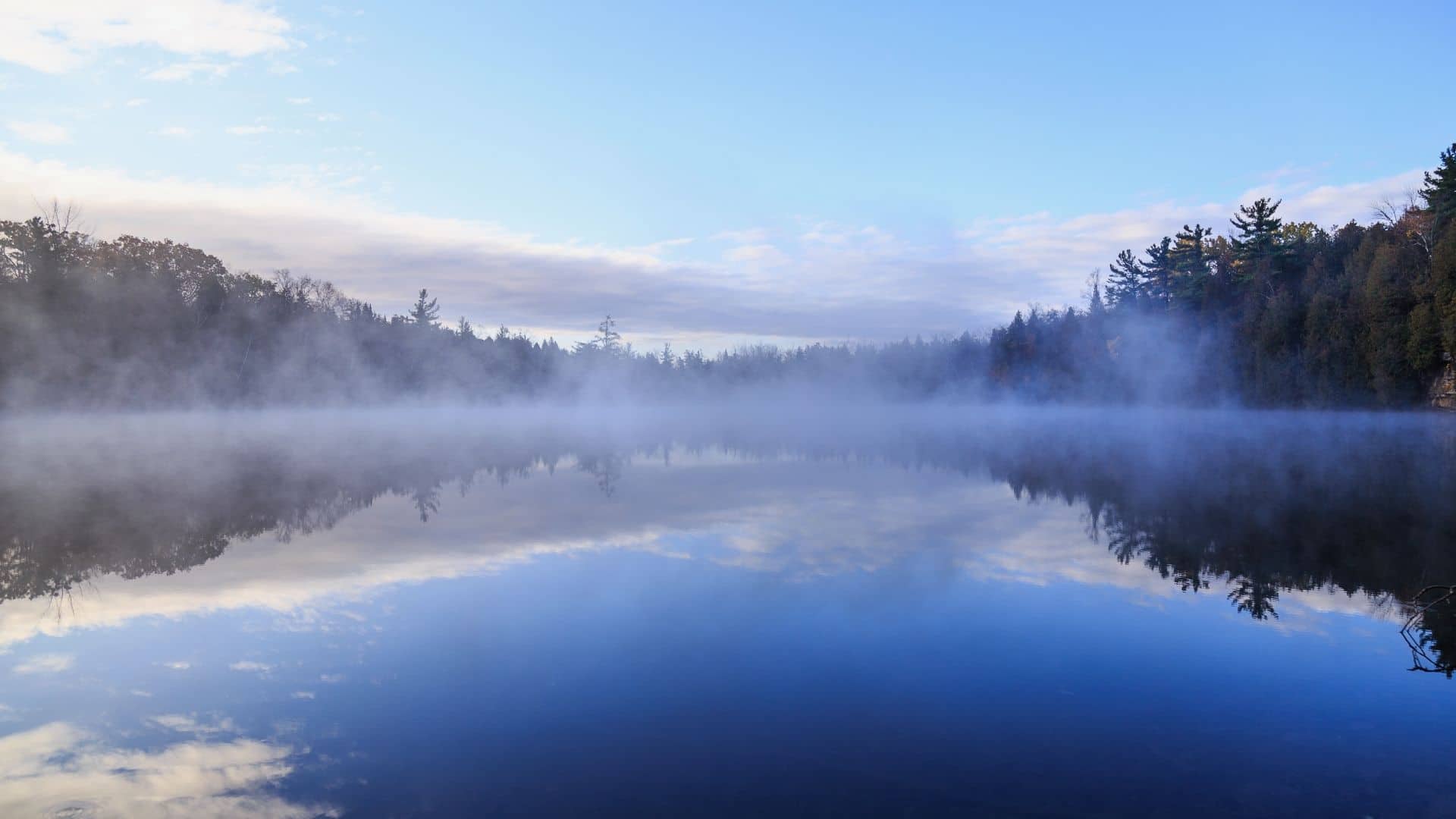
Geologically, such a spike is still very small. after all the real carbon age did not get significant until we jumped on oil and then maturity came with WWII. So we have had about eighty years of carbon signal optimization..
A century is acually a small time window and carbon does not build sedimentation or mass. So a marker is possible but that is it.
Today we are about to remove oil as our fuel base. any such signal will disappear.
What will provide a global signal will be a population expansion based on completely sustainable land husbandry. Forests will cover all lands and they will be managed. will that look different in the geological record? I do not know.
The Search for the Golden Spike
Scientists all over the world are digging deep to discover our exact spot in the geological timescale, and the stakes have never been higher.
https://orionmagazine.org/article/golden-spike-search-geology/
ALARMED BY FAST-GROWING SCARS of climate change, extinction rates, and ocean acidification, geologists from the International Commission on Stratigraphy—tasked with defining the official Geological Time Scale and known for their glacially-paced analyses—have begun to examine evidence that we have entered a new geological epoch called the Anthropocene.
In 2019, a review began of eleven main sites around the world in search of a “golden spike” indicating this massive shift in the Earth System. Like the meteorite dust that heralded the demise of the dinosaurs at the end of the Cretaceous, the golden spike is a signal in the strata that must be global and synchronous. It must represent an environmental shift so intense that the entire planet crosses a threshold into a completely new biogeochemical paradigm.
“When the Earth System goes from a previous state to a new state,” explains Anthony Barnosky of Stanford University and the Anthropocene Working Group, “what happens in the transition is a lot of bouncing back and forth between something resembling what’s going to be the new state, and what looks a little more like the old state—really wide fluctuations. That’s probably where we are right now.”
“Earth will never go back to Holocene levels, but what we don’t know,” he says, “is where it’s going to settle out. We yet have agency to drive which direction we go.”
Though mid-century plutonium has emerged as the frontrunner for the new epoch’s golden spike, a tidal wave of other signals are also coupled with its rise. Some of these signals in the rock, like plutonium, sulfur, and DDT have been largely curbed through hard work and local, national, and international restrictions. Others, like greenhouse gasses, plastics, and biomass loss, continue to rise with dire consequences.
Follow the search for the golden spike here to learn more about each site as the science continues to unfold.

Crawford Lake, Ontario (Andrea Arrogante/Conservation Halton)
CRAWFORD LAKE, CANADA
Material: Chrysophytes
DEEP IN THE WINTER FREEZE of Ontario, Canada, tiny glass creatures—delicate as snowflakes—fall through the watery depths of Crawford Lake. These chrysophytes, a type of freshwater algae, bloom near the surface in the summer, constructing exquisite shells of latticed silica around their soft, single-celled bodies. As the temperatures plunge, they die and settle at the bottom of the lake in a dark, organic layer in the sediment. The following year, when the water warms again, chalky white calcite precipitates out from the surrounding rock into a bright layer of summer sediment. These seasonal layers, or varves, of dark and bright, have stacked one on top of the other in this way undisturbed for over a thousand years.
Crawford Lake is very small and very deep. It was formed millennia ago when a massive glacier sheared off the top of a limestone sinkhole within the Niagara escarpment. Though you can wend your way around it through cedar and maple trees in fifteen minutes, the lake plunges seventy-seven feet deep into the earth, and like a natural test tube, has collected layers of sediment year after year. Taken together, the chrysophyte layers —borne of a species sensitive to different temperatures, salinities, and pHs—tell a story. In 1750, humans produced .0009 gigatons per year of atmospheric carbon; in 1950, 5.3; and in 2017, 36.1 gigatons. Since preindustrial times atmospheric carbon has risen from 278 parts per million to almost 421 this year—and it’s still rising exponentially. As a marker, the glass creatures signal the overall global acidification of earth, as this carbon-laden air continues to dissolve into our freshwater systems. This lake may be far removed from human activity, but it is never disconnected.
Left: Coring Crawford Lake. Cedar boughs lined the auger hole in a Wendat ceremony prior to drilling. (Andrea Arrogante/Conservation Halton)
Right: Varves focused on the 1950s. The proposed base of the Anthropocene is in the dark layer at the center of the image.
(Ms. Krysten Lafond, Dr. Nawaf Nasser, Dr. R. Timothy Patterson)
From the Expert: When I started working on this, I assumed that the biggest change would be associated with the Industrial Revolution. But when we do the statistical analysis, the lake experiences a major change in the mid 20th century that I would not have predicted, because there was nothing out there—this lake in the 1950s was in the middle of a rural area of Ontario.
— Francine McCarthy, micropaleontologist and professor of Earth Sciences at the Faculty of Mathematics and Science at Brock University, Ontario, Canada

Śnieżka summit (Beata Smieja-Król)
ŚNIEŻKA PEATLAND, POLAND
Material: Moss
IN THE HEART OF EUROPE’S “Black Triangle,” a vast peatland surrounds the high mountain of Śnieżka. Within the peat, aerosolized, microscopic spheres of black carbon lay trapped in the top layer of living moss. These Spheroidal Carbonaceous Particles, or SCPs, are by-products created from high temperature combustion of coal and oil. They are found in all environments on every continent, including Antarctica. In the feathers of this sphagnum moss, a testate amoeba is found, who has collected tiny, round, bits of pollution to construct its shell.
In Śnieżka the peatland is ombotrophic, meaning that its roots grow above the water table. The airy moss sustains itself purely on the moisture and nutrients it catches from the rain and icy fog that rolls across it each day. Because of the peat’s isolated, filter-like existence, pollution gets trapped in its moss year after year. Each layer compresses beneath new growth, forming denser and denser layers of peat—and the first dark inklings of lignite coal—they capture a history of earth’s air quality. Back in the lab, under the gaze of an electron microscope, black spheres of carbon tell a story of “dead” carbon’s global rise since the industrial revolution. They peak around the world in the 1960s and then fall due to tighter pollution controls that began in the 1970s.
Left: Coring using stainless steel Wardenaar corer. (Marek Król)
Right: Peatland core. (Barbara Fiałkiewicz-Kozieł)
From the Expert: I realized that Śnieżka is a really important place because, on one hand, its history is very original, but on the other hand, it can be considered an analog of other sites in other parts of the globe—we have the same story.
— Barbara Fiałkiewicz-Kozieł, professor assistant at the Department of palaeoecology and biogeography of Adam Mickiewicz University

Field camp at the Palmer core collection site on the Antarctic Peninsula ice sheet. (Liz Thomas)
PALMER STATION, ANTARCTIC PENINSULA
Material: Meltwater
INSIDE AN ICE CORE winched from the Antarctic Peninsula, air bubbles dating back to 1621 are suspended in ice, frozen in time. The peninsula, jutting out into a shared ocean with Chile and Argentina, is extremely sensitive to changes in climate from heat-trapping carbon pollution (as recently as 2017, a section the size of Delaware broke away). This particular ice core from Palmer Station was shipped to the UK, where a specialized hotplate slowly warms its inner core, allowing the meltwater to be collected. As the trapped air bubbles dissolve, they are analyzed for historical air composition.
One of the most prominent signals in the data is methane. Methane, made up of one carbon atom and four hydrogen atoms, is the most potent heat-trapping gas on the planet—eighty times more powerful than carbon dioxide. This year, it exceeded 1900 parts per billion, shattering all previous records that have been kept since the 1980s. An estimated 65% of methane release is due to human activity, including unchecked organic decomposition in landfills, unsustainable agriculture, cows’ gut fermentation, and flaring during oil and gas production. Unlike carbon dioxide, it only takes a decade to break down in the atmosphere, meaning a reduction is key to limiting climate change. Yet if temperatures continue to rise and the frozen ice—our protectors—continue to melt, this ancient air will rise and rise.
Left: Drilling the core and cutting it into 80-cm-long-sections on site.
Right: Image of an ice core section displayed at the British Antarctic Survey. (Images: Liz Thomas)
From the Expert: I think ice cores are fantastic—they can take us thousands of years back in time. And that is really, really interesting. However, I’m also a human. And I’m personally very interested in what’s happening now. And what’s going to happen in the future.
— Liz Thomas, paleoclimatologist and head of the British Antarctic Survey’s ice core group

San Francisco Bay, California (Mariusz Blach)
SAN FRANCISCO BAY, CALIFORNIA
Material: Neobiota
EMBEDDED IN THE MUDDY SILT of San Francisco Bay, histories of migration and trade stack one on top of the other, traced through the introduction of neobiota, or nonnative species, into the bay. Some neobiota like barnacles caught rides on the bows of ships sailing across the Pacific, while others, like Atlantic Oysters, were intentionally put on the transatlantic railway and sent on a trip across the country before being dumped into the estuary. San Francisco, whose trade saw $9.78 billion in 2019 alone, is one of the world’s most altered ecosystems (or at least one of the best documented). With California’s 1849 Gold Rush, it became a focus for trade and migration. But it wasn’t until after WWII that trade exploded along new routes established during wartime. In unprecedented waves of post-war globalization, neobiota predominantly traveled from East Asia and South America, and starting in the 1970s, from Japan and China. Today, over 200 new species live in the bay, ranging from amoebas to mollusks to plants.
This pan-continental trend of globalization and connectedness has greatly increased the annual rate of neobiota transferring around the world. Species inventories, like those of San Francisco Bay, record significant and rapid changes in seas, rivers, estuaries, and on land that signal highly-disturbed ecosystems. In the U.S. alone, more than 6,500 of introduced species cause more than 100 billion dollars in damage each year, affecting crops, clogging waterways, transmitting diseases, increasing fire vulnerability, and threatening native fish populations.
Left: View from the back of the coring boat USGS Snavely.
Right: Close up view of the top 23 cm of a San Francisco Bay core. (Images: Stephen Himson)
From the Expert: It’s not until after the Second World War, that you get this massive influx of Asian and South American species from an explosion of trade. Most fossils of the invasive species that I’ve got in my cores are Asian species from China and Japan that arrived in the 1970s and 1980s.
— Stephen Himson, postgraduate researcher at the Department of Geology, Leicester University

Speleothems in Ernesto Cave, Italy (Andrea Borsato)
ERNESTO CAVE, ITALY
Material: Speleothems
IN THE UNDERWORLD of Ernesto Cave in Italy, water drips from a stalactite and onto the floor. The stalactites and stalagmites, called speleothems, are formed over thousands of years and record everything from the atmosphere aboveground, including human-driven emissions of sulfur, which exceed natural levels by two to three times. The pre-industrial signal of sulfur, originating from natural sources like sea-spray, mineral dust, and volcanic eruptions, rose during the industrial revolution in Europe, accelerated during the mid-century, when the trees and soil above the cave became over-burdened, and then took a nosedive, due to restrictions enacted against sulfur emissions in the 1980s.
The atmospheric gasses aboveground, like sulfur dioxide from sulfur-bearing coal, dissolve into rainwater and are taken up by soil microbes and the roots of trees growing above the cave. There they cycle for 20 years within this living, biogeochemical reservoir, before percolating through groundwater into the roof of the humid cave. Humidity in the cave is one hundred percent and gas pressure is low, so the supersaturated gasses crystalize out of the water, forming layers that function as micro-thin archives dating back thousands of years. In this way, the aboveground atmosphere’s chemical composition is transmitted overtime into a high-fidelity record preserved in the fragile otherworld.
Left: Renza Miorandi measuring the drip rate of stalactite feeding stalagmite ER76 in March of 2002 (Andrea Borsato)
Right: Axial cut of stalagmite ER76 (Renza Miorandi/Museo delle Scienze, Trento)
From the Expert: The pressure of the CO2 gas in the [groundwater] is very high with respect to the atmosphere of the cave. And this means that as soon as a water droplet enters the cave on the stalactite it loses CO2 to the atmosphere. Instead of dissolving limestone like in the aquifer, it is precipitating limestone into rock.
— Andrea Borsato, Senior Research Associate of the School of Environmental and Life Sciences at the University of Newcastle, Australia
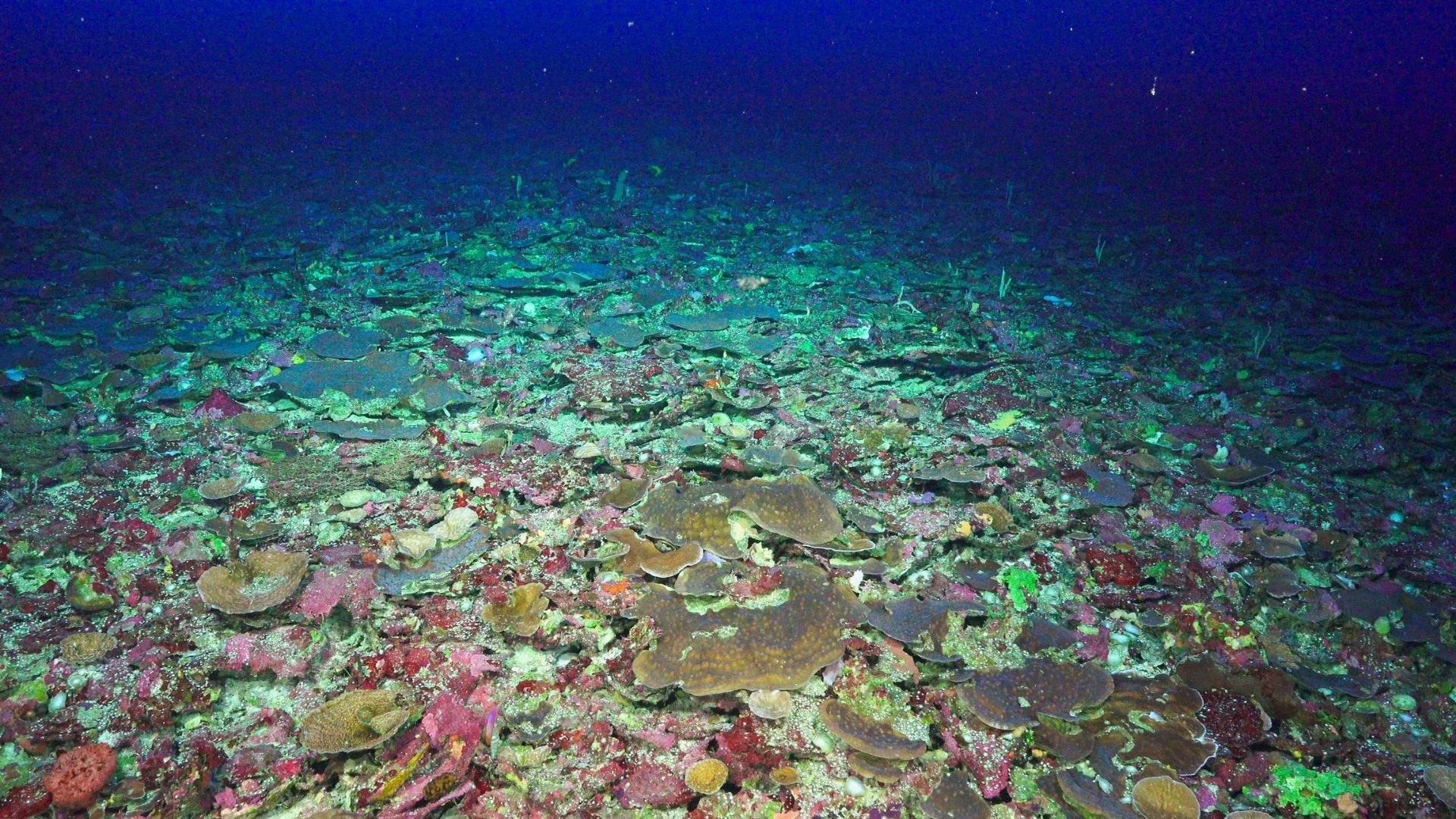
Flinders Reef, Australia (Schmidt Ocean Institute)
FLINDERS REEF, AUSTRALIA
Material: Coral
BENEATH THE COLORFUL Coral Sea off the coast of Australia lies Flinders Reef, home to more species and varieties of coral than any other single reef along Australia’s coast. The reef is made of colonies of tiny animals called coral polyps that build calcium carbonate exoskeletons around themselves. As the exoskeletons grow beneath the polyps, their growth rings respond to pH, temperature, and salinity. Like any other living creature, they absorb chemicals from their environment.
Corals depend on tiny algae called zooxanthellae that live symbiotically with them and provide 90% of the energy for their cells. But when the sea surface temperature goes too high, the coral expel the zooxanthellae and turn bone-white, a process known as bleaching. More than 90% of the warming caused by climate change is stored in the ocean. Because of this, heat-trapping pollution is increasing the frequency and intensity of bleaching events in reefs around the world. In the nearby Great Barrier Reef, of 171 individual corals surveyed, 43% bleached in 1998, 56% in 2002, and 85% in 2016. Without their symbionts, bleached corals become stressed and, starved of energy, will often die. Those that survive bear a high-density stress-induced growth scar. Their skeleton is a historical thermometer of sea surface temperature spanning hundreds of years.
Left: Drilling a massive Porites coral at Flinders Reef in the Coral Sea (Tāne Sinclair-Taylor)
Right: X-ray image of the Flinders coral core (Neal Cantin and Grace Frank/Australian Institute of Marine Science)
From the Expert: What I really find interesting is that we’re doing all this analysis on the same materials, which has hardly been done. There’re not many studies where so many different proxy systems have been applied and we will be in a good position to compare different environmental parameters and how they’ve changed over time. If it makes a difference in the end in understanding human impacts, then I think we fulfilled our mission.
— Jens Zinke, Professor in Palaeobiology and Royal Society Wolfson Fellow at the University of Leicester, UK
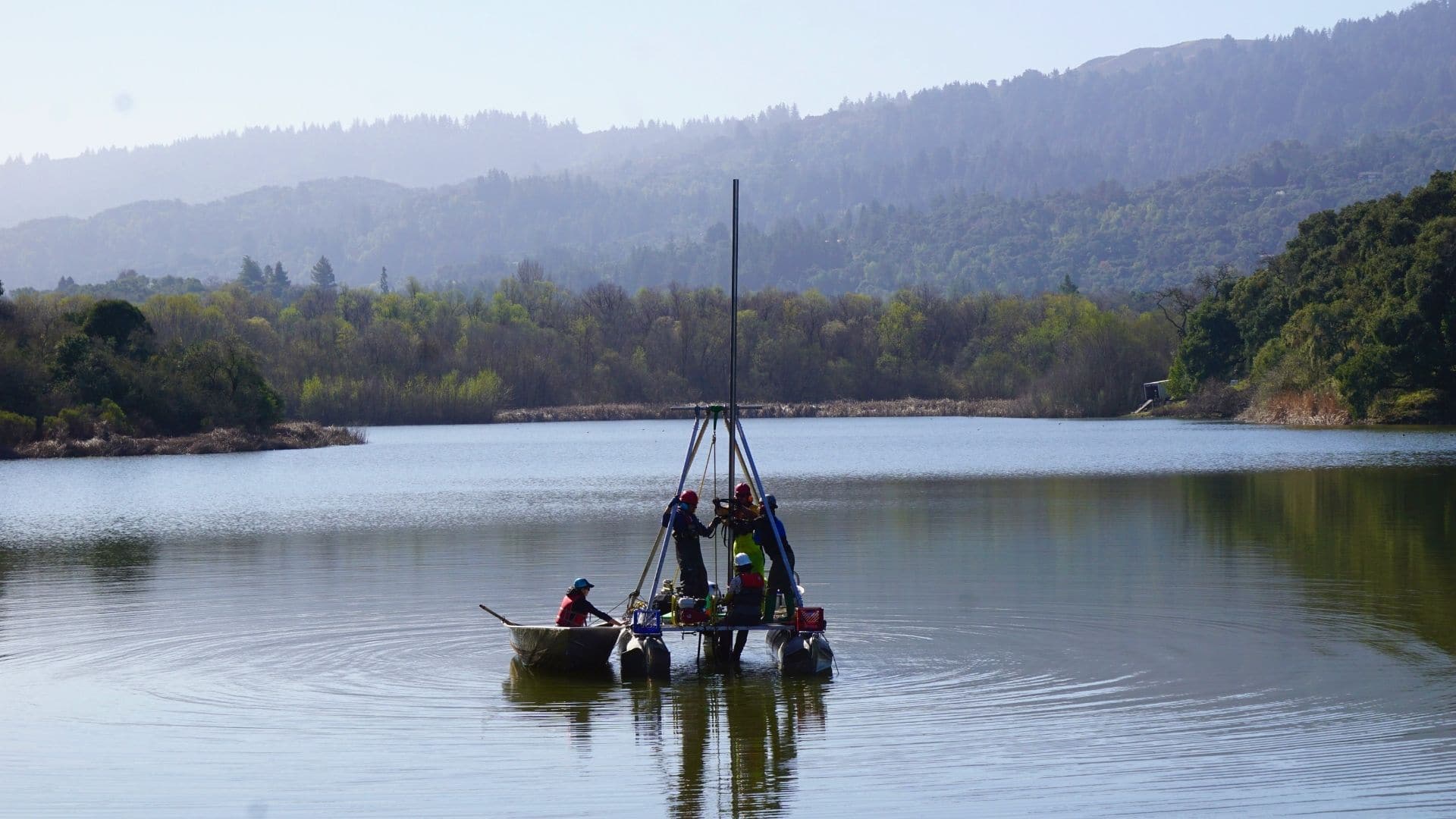
Coring Searsville Reservoir, October 2018 (Elizabeth A. Hadly/Stanford University)
SEARSVILLE LAKE, CALIFORNIA
Material: Silts
AT THE BOTTOM OF a steep drainage flowing from the Sierra Mountains of California, a dam was built from poured concrete blocks in 1892. The water of San Francisquito Creek, first trapped in the reservoir with the intention of providing drinking water to the booming city of San Francisco, turned out to be smelly and full of grit, and was diverted into irrigation for agriculture instead. With each winter rain, large pulses of eroded sediment have flowed into the reservoir and become trapped against the dam while each summer decomposing aquatic plants and algae settle on the lakebed. In this way, the dam has filled to the brim with a record of alternating, seasonal layers of silt, which capture snapshots of pollen and insect DNA from changing populations of plants and animals, mercury from the Gold Rush, storm pulses, and earthquakes from the nearby San Andreas Fault. A human-built sediment trap, Searsville Lake has created a 129-year geological archive of human impacts.
Now growing a wall of mosses and ferns upon its surface, the Searsville Dam is part of what is collectively called the Technosphere: human-made, non-living stuff such as dams, roads, buildings, factories, and infrastructure for water and electricity. Altogether the Technosphere amasses an estimated 30 trillion tons, nearly 40 pounds per square foot on the surface of the earth. Much of the Technosphere is made from carbon-emitting concrete: in 1904, 140 miles of pavement spider-webbed its way across the country, while today 2.7 million miles of US roads are covered in asphalt or concrete. Global cement and concrete production have risen from .13 gigatons per year, to 4 gigatons and 27 gigatons, respectively, over the past seventy years. Today, this crust of our stuff outweighs us by a ratio of sixty thousand to one.
Left: Searsville Lake, California (Sundry Photography)
Right: A section of the core in the lab, sampled for Mercury analysis. (M. Allison Stegner/Stanford University)
From the Expert: It’s one of the only sites being considered right now that only exists because of the activity of humans. We have created this geological archive.
— Alison Stegner, postdoctoral researcher at Stanford University
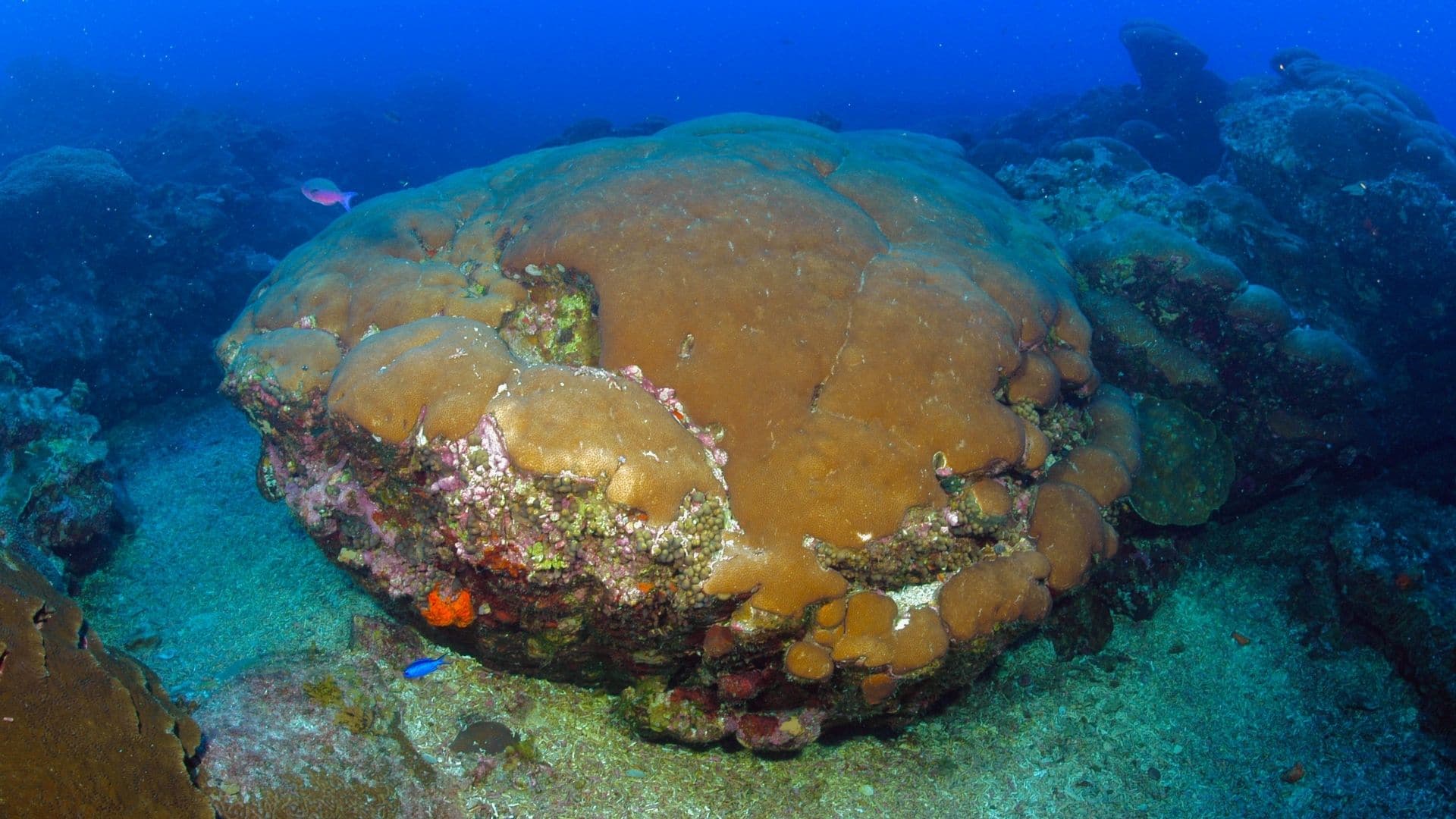
Massive starlet coral, Gulf of Mexico (G.P. Schmahl/Flower Garden Banks National Marine Sanctuary)
WEST FLOWER GARDENS BANK REEF, LOUISIANA
Material: Corals
IN THE CLEAR, BLUE WATER of West Flower Garden Bank Reef, large boulder-like stony corals called massive starlet corals grow to over six feet across. Though corals in this area usually grow in the shallow waters around islands or eroded volcanoes called atolls, West Flower Gardens Bank Reef grows atop an ancient salt dome. Eons ago, the Gulf of Mexico was a shallow sea, and its gradual evaporation laid down a layer of salt upon the seafloor, which over time became buried by sand. Because salt is less dense than other types of sediment, it’s worked its way to the surface, causing large bulges in the seafloor that are now filled with oil and gas deposits. Because of this, more than 9,000 offshore platforms have launched their operations in the northern Gulf of Mexico.
The sensitive starlet corals track the explosion of the oil and gas industry in a few ways. Coral records oil exploration through changes in barium concentrations (once mistakenly thought to remain immobile in the sediment) and was used to flush drill holes. They also record the rising levels of “dead” carbon in the atmosphere and ocean, carbon emitted from burning oil and gas (which has a different isotopic signature than organic carbon). Since 1950, humans have burned more energy in the form of fossil fuels than in the entire 11,700 years of the Holocene preceding our generation. Additionally, the ocean’s increasing exposure to microplastics, also a product of fossil fuels, has impaired coral growth over time.
Left: A diver drilling a stony coral in 2005 (Emma Hickerson/Flower Garden Banks National Marine Sanctuary)
Right: Coral core quarter sections of 05WFGB3-1-A awaiting analysis (Kylie Palmer)
From the Expert: When I first went out, there was a platform right next to the reef that’s since been decommissioned and removed below the waterline so it’s not a navigational hazard. But that bottom structure is still there. Fish hang out on it. It’s kind of weird to be out there diving around this beautiful coral reef off an oil platform.
— Kristine DeLong, paleoclimatologist and Associate Professor in the Department of Geography and Anthropology at Louisiana State University

Satellite image of algal blooms around Gotland Island in the Baltic Sea. (NASA’s Goddard Space Flight Center/USGS)
BALTIC SEA, GERMANY
Material: Dead Zones
THE BALTIC IS A semi-enclosed, shallow sea, whose coastline is shared by Germany, Poland, Lithuania, Estonia, Russia, Denmark, Finland, and Sweden. Two hundred different rivers drain into its brackish waters. On a whole, humans have significantly altered over two-thirds of earth’s land surface and marine environments, and the Baltic is no exception. During WWII massive amounts of food were needed to sustain large armies at huge distances. Widespread use of fertilizers using the Haber-Bosch process, pesticides, and mechanization allowed farmers to increase their harvests with only a fraction of the workforce, and advances in canning and transportation led to an unprecedented level of agricultural production. Post-war, fertilizers (made in nitrogen production plants first used to manufacture bombs) and pesticides like DDT (first used in wartime to combat malaria in troops) continued to be used on crops and livestock. Though DDT has been largely banned in Europe since the 70s, its derivatives remain in soil and food sources around the world. Today, half the nitrogen in our bodies comes from synthetic fertilizers.
One of the main consequences of fertilizer overuse occurs when it washes into watersheds and enters bodies of water. Algae and bacteria feed on the nutrient influx and respond in massive blooms—using up all the oxygen in the water and making it inhospitable for other creatures. These “dead zones,” also known as eutrophication, are spreading across the Baltic, preserving the sediment layers in pristine condition. High levels of runoff containing nitrogen and phosphorus from industrialized agriculture have made the Baltic one of the most eutrophic seas on the planet.
Left: The water-sediment interface in a short sediment core recovered by the multicorer.
Right: The Multicorer used to retrieve short sediment cores. (Jérôme Kaiser)
From the Expert: With more than 200 rivers of freshwater flowing into the Baltic Sea, you have this human impact. Cyanobacteria really started to bloom after the 1950s because of this input of nutrients related to industrialized agriculture.
— Jérôme Kaiser, head of the laboratory for biomarker analysis at the Leibniz Institute for Baltic Sea Research Warnemünde
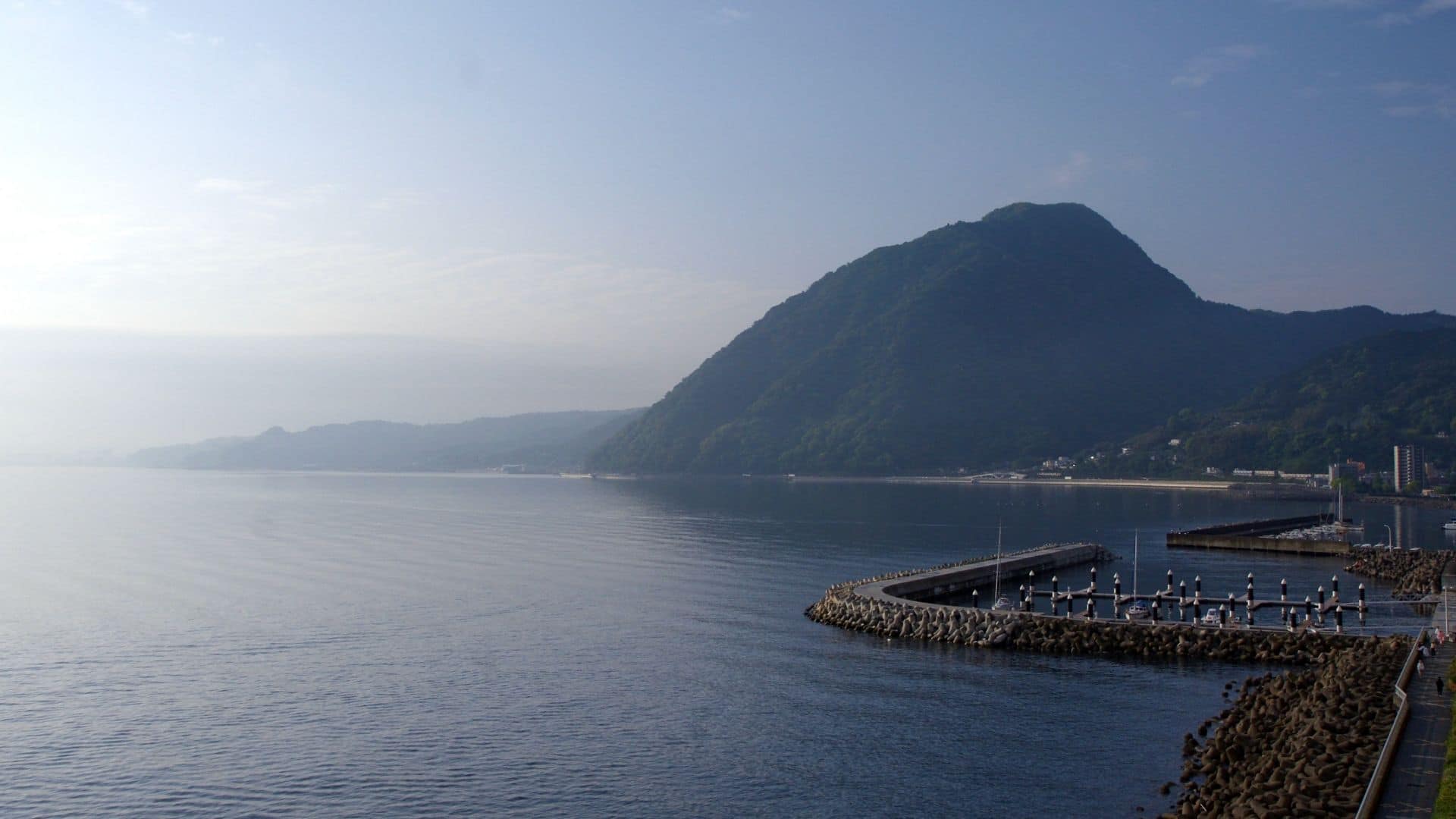
Beppu Bay, Japan (Wikimedia Commons)
BEPPU BAY, JAPAN
Material: Anchovies
ON THE MOUNTAINOUS COAST OF Kyushu, one of Japan’s five main islands, silver anchovies and sardines dart through the water. Their opalescent scales, like trees, have annual rings, and their chemical composition reflects that of their environment—now and in the past. Fossil fuel combustion, synthetic nitrogen from fertilizer, and chemical waste all show up, as do nuclear isotopes from above-ground testing and the Fukushima nuclear disaster. In Beppu Bay, the record of shed fish scales goes back 2,850 years, preserved in the bay’s silty, low-oxygen clay. Though Beppu Bay’s fish don’t show a significant decrease in population yet, across the oceans as a whole, they are declining.
Small pelagic fish like sardines and anchovies live in nutrient rich upwellings off the coasts of California, Peru, the Canary Islands, South Africa, Japan, and Argentina. Around the world, they make up a large portion of the seafood that provides up to half of all animal protein eaten in developing countries. In 1950, no species of fish were considered troubled. By 2006, that number reached eighty-seven percent of fish species who were considered exploited, over-exploited or collapsed. Indeed humans are driving staggering biomass loss of fish and wild animal populations. Today, ninety-six percent of our earth’s mammalian biomass is made up of humans and our domesticated animals. Poultry represents seventy percent of all living birds. One million species face extinction, and without steep intervention, many will disappear within decades.
Left: Fish scale samples in the lab. (Eri Furuichi and Akane Yamamoto)
Right: Researchers measure dry bulk density and magnetic susceptibility in a core subsample. (Michinobu Kuwae)
From the Expert: Nitrogen cycle change is a powerful Anthropocene signature from our site. Stable nitrogen isotopes were measured by bulk anchovy fish scales which show the excessive supply of reactive nitrogen in the terrestrial and aquatic environments due to the use of fertilizers produced from airborne nitrogen gas in the Haber–Bosch process as well as the input of nitrogen oxides (NOx) derived from fossil fuel combustion.
— Michinobu Kuwae, associate professor for coastal paleoceanography and paleontology at the Center of Marine Environmental Studies at Ehime University

The Sihailongwan Lake. (Ji Pengfei/Jilin TV Station)
SIHAILONGWAN MAAR, CHINA
Material: Mercury
WITHIN A 700 SQUARE MILE volcanic field in northeastern China, 164 volcanic crater lakes and cones pock the earth’s surface. Sihailongwan Maar is an ancient caldera filled with water from monsoons, which bring up to 30 inches of rain each year. With no inflows or outflows, the maar is made of dark basalt, meaning the matter that blows in and settles on its surface is preserved layer after layer in the sediment.
In the winter, the maar freezes over, allowing it to be cored and studied. In the core, the varves hold soot and mercury—both from fossil fuel pollution. Mercury begins in the varve from 1860 and from there it increases exponentially, following carbon pollution’s curve. Since industrialization, human smelting, refining, and fossil fuel pollution have disrupted the slow, natural cycles of metals in earth’s crust, including cadmium, nickel, copper, mercury, and lead. The release of mercury into the environment has led to widespread global mercury pollution. Shallow ocean waters of 300 feet have tripled in mercury concentration since the Industrial Revolution. Today, almost all people in the world have at least trace amounts of methylmercury in their tissues.
Left: Coring in the Sihailongwan Maar Lake.
Right: Freeze core collected in the Sihailongwan Maar Lake. (Yongming Han)
From the Expert: The core records an overall increasing trend of soot, mercury, and Spheroidal Carbonaceous Particles (SCPs)—all from fossil combustion—since 1950. However, there are three anomalous dips in soot and mercury, which correspond to political events in China: the Chinese economic reform in 1978, which temporarily disrupted industry; the implementation of a desulfurization subsidy from 2004, which incentivized coal plants to reduce their sulfur emissions; and the Air Pollution Prevention and Control Law from 2012, which held local governments accountable for improving air quality.
— Yongming Han, researcher at the Research Division o











No comments:
Post a Comment